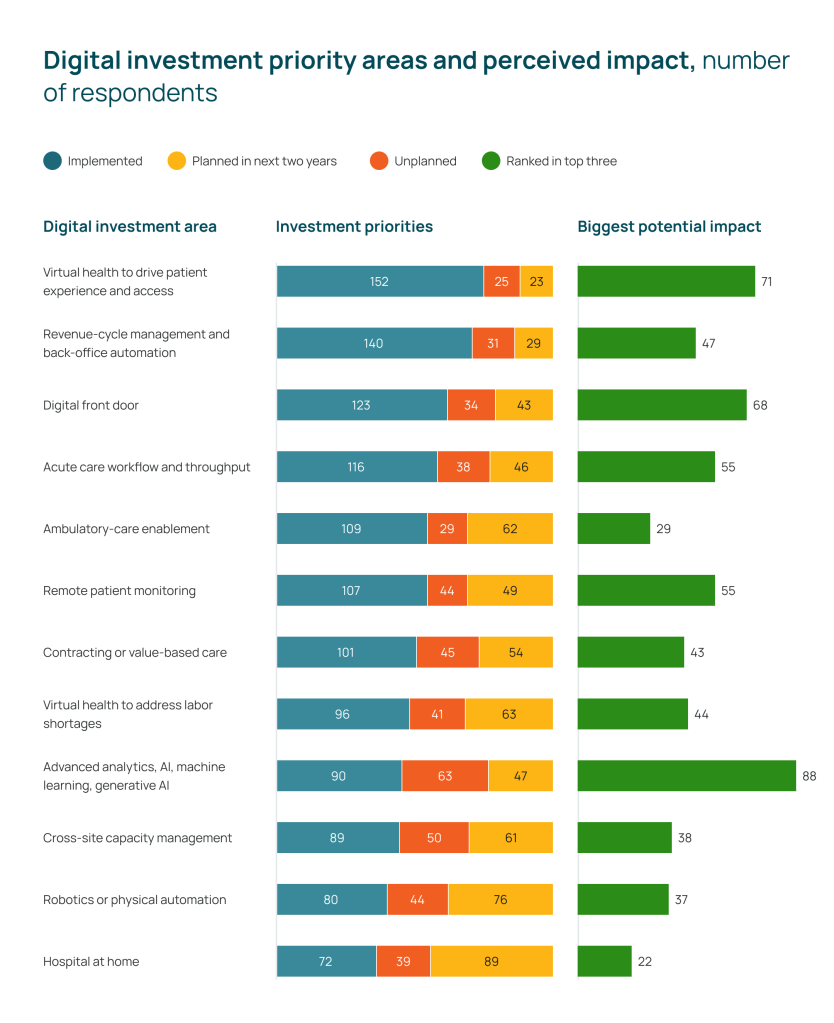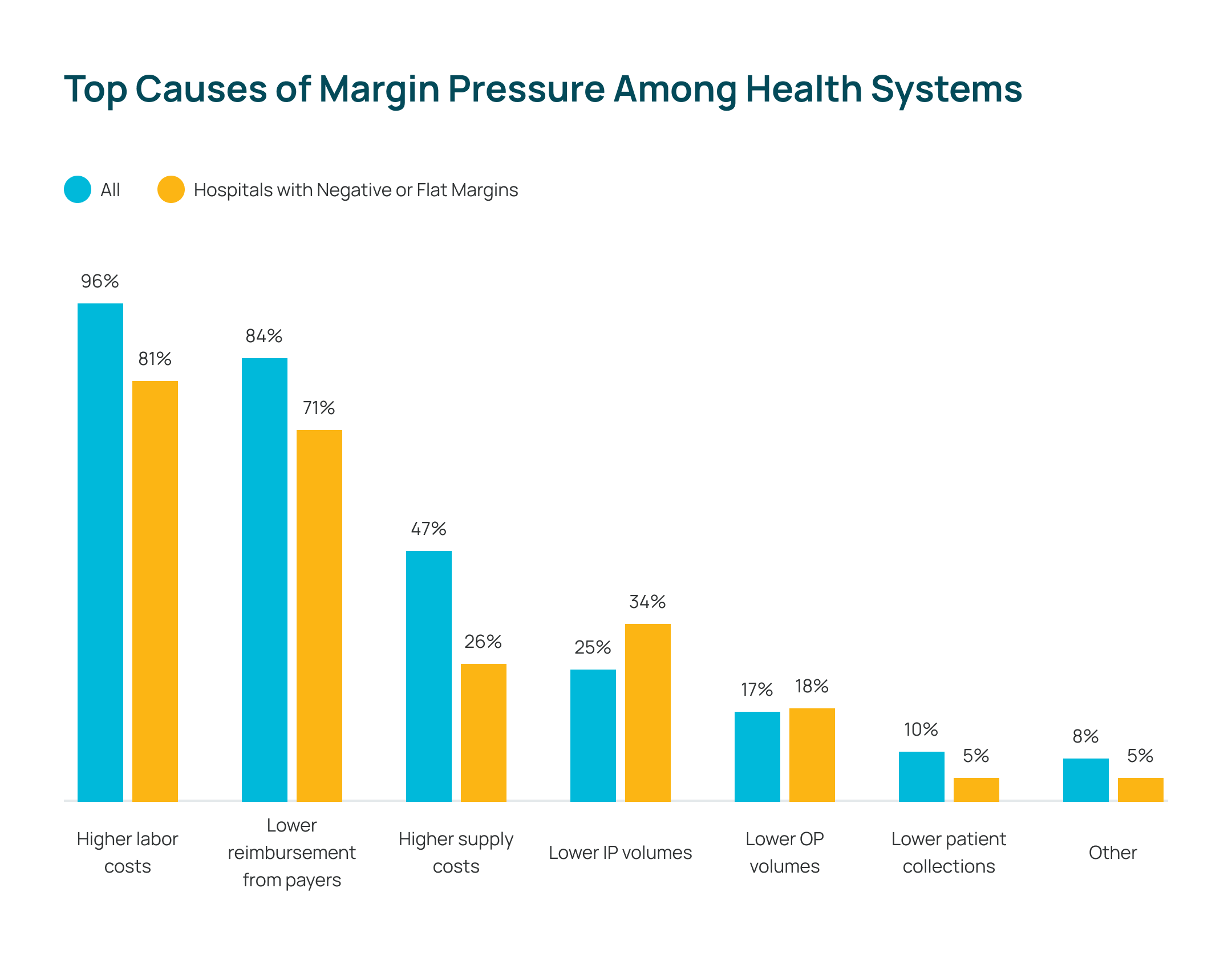AI in Healthcare: Facing Fears and Embracing Innovation
As AI’s transformative power in healthcare becomes increasingly evident. it also raises significant concerns among healthcare professionals about its impact on clinical decision-making and patient care. Working with healthcare leaders across the country on developing workforce strategies over the past 15 years, I’ve gained insight on technology can improve their clinical operations and financial status. In this article, I share the findings from my discussions on the current market trends, address common apprehensions and highlight how thoughtful AI integration can create a more efficient and patient-centered healthcare system.
State of the Market
The healthcare landscape is evolving rapidly, with several key trends shaping the industry’s future:
-
- Rebounding Hospital Operating Margins: Recent data from Kaufman Hall shows a significant improvement in hospital operating margins, primarily due to increasing utilization and a normalizing labor environment. Hospitals are beginning to recover from the financial strain caused by the pandemic, setting the stage for strategic investments in technology (Kaufmann Hall via Hospitalogy / Adonis report).
- Untapped AI Potential: According to a McKinsey report, AI represents an unrealized opportunity for health systems and is seen as the digital investment area with the biggest potential impact. Many healthcare organizations have yet to fully leverage AI’s capabilities across various domains such as diagnostics, patient management and administration. The potential for AI to revolutionize healthcare delivery is immense, but adoption remains uneven and fragmented (McKinsey via Hospitalogy / Adonis report).
- Growing Concerns About AI: As more capabilities become available, there’s mounting apprehension about AI in healthcare. Recent protests by nurses highlight concerns about AI’s role in clinical decision-making and patient care. These concerns underscore the need for thoughtful implementation and continuous dialogue between AI developers and healthcare professionals to facilitate ethical and effective use.
These trends create a complex landscape where opportunity and caution intersect. As hospitals regain financial stability, they are in a better position to invest in innovative technologies like AI. However, the full potential of AI will only be realized if healthcare providers can address the legitimate concerns of frontline workers and ensure that these tools are integrated in ways that enhance, rather than hinder, patient care.
Deconstructing AI Concerns
To address the concerns surrounding AI in healthcare, it’s crucial to understand what AI really means in this context:
- AI is Not Monolithic: AI encompasses a wide range of technologies, each with different applications and impacts. Machine learning, for instance, is a subset of AI that uses algorithms to identify patterns and make predictions based on data. In healthcare, machine learning is employed in applications like Workforce AI to predict staffing requirements by analyzing historical data, patient volumes, and other variables to forecast labor needs. This improves operational efficiency, allowing hospitals to have the right number of staff on hand to meet patient demand.
- AI as a Collaborative Tool: One of the primary fears surrounding AI in healthcare is the misconception that it will replace healthcare workers. However, effective AI implementation is not about replacing humans but rather expanding their capabilities. AI can handle repetitive tasks, analyze large datasets, and provide decision support, allowing healthcare professionals to focus on more complex and nuanced “human” aspects of patient care. The key to successful AI integration is ensuring that technology and human expertise work hand in hand.
Reinforcement Learning from Human Feedback (RLHF)
An inspiring concept in AI development is Reinforcement Learning from Human Feedback (RLHF). This approach aligns AI systems with human preferences by incorporating ongoing human input. In healthcare, RLHF principles can ensure that AI tools evolve based on the expertise of clinicians and healthcare providers.
The integration of AI, particularly through RLHF, requires that we strike a balance between control and burden. For example, a hospital might implement an AI-driven electronic medical records (EMR) system that uses RLHF. Initially, clinicians are required to provide ongoing feedback on the system’s performance and suggest improvements. This process might seem burdensome as it demands extra time and effort from already busy healthcare professionals. However, this input allows the AI to learn and tailor its functions to the clinicians’ needs and workflows.
By continuously adapting to the preferences of healthcare professionals, AI empowers healthcare systems to alleviate administrative tasks and enhance clinical decision-making and patient care. Embracing AI-driven solutions is essential for the future of healthcare, providing a more efficient, accurate and user-friendly approach to managing patient care.
The Reality of Labor Costs
Labor costs remain the top cause of margin pressure for health systems, significantly impacting their financial stability. The high cost of labor is driven by several factors, including staff shortages and the increased demand for healthcare services. These pressures are exacerbated by the need to maintain high standards of patient care, which often requires a substantial investment in skilled personnel. As a result, healthcare systems are constantly seeking ways to balance their budgets while maintaining the highest quality of patient care.
This reality underscores the urgent need for innovative solutions that can optimize workforce management. AI-powered tools can play a pivotal role in this effort. For instance, predictive analytics can forecast staffing needs based on patient volume trends, seasonal fluctuations and other variables. By accurately predicting staffing requirements, health systems can allocate resources more efficiently, reducing the reliance on agency labor and minimizing overtime expenses while maintaining high quality patient care.
Ultimately, the integration of AI into workforce management is not just about cutting costs; it’s about creating a more resilient and adaptable healthcare system that can meet the needs of both patients and providers. Leveraging AI’s potential will be key to overcoming labor cost challenges and ensuring the long-term sustainability of healthcare services.
Dani Bowie, DNP, RN, NE-BC, Senior Vice President of Solutions Design at Workforce AI for Aya Healthcare, has long recognized the transformative potential of AI in healthcare. Her passion for AI stems from her doctoral work in 2015, where she developed a predictive scheduling model to address nurse staffing issues. Despite initial resistance from health systems and vendors, she remained committed to her vision.
“With AI becoming mainstream through products like OpenAI, ChatGPT, and Siri, most Americans are now aware and accepting of AI. This shift opens new opportunities in healthcare. AI can provide accurate forecasting models and strategic business recommendations that will reduce the administrative burden of front-line managers, drive down excessive labor costs, and ultimately solve long-standing workforce challenges.”
What’s Next for Healthcare AI
As we navigate the integration of AI in healthcare, there are key considerations that can guide us towards successful and meaningful implementation:
- Approach AI with Curiosity: Instead of viewing AI as a threat, healthcare organizations should approach it with an open mind. Exploring the potential benefits of AI can lead to innovative solutions that improve patient care and operational efficiency.
- Inclusive Decision-Making: Involving clinicians and administrative personnel affected in the decision-making process is crucial. Their expertise and firsthand experience are invaluable in developing and implementing effective AI solutions. By giving end-users a seat at the table, healthcare organizations can foster a sense of ownership and collaboration.
- Implement RLHF-Inspired Processes: Adopting processes inspired by RLHF allows AI tools to continually learn from and adapt to the needs of healthcare professionals. By mirroring RLHF principles in solution implementation and usage, healthcare organizations can create AI systems that are responsive, reliable and effective.
By embracing these principles, healthcare organizations can harness the power of AI to address pressing challenges like labor costs while maintaining a focus on quality patient care. The future of healthcare lies in finding the right balance between technological innovation and human expertise. It is crucial to keep an open dialogue about AI’s role in healthcare, ensuring that it serves as a tool to enhance, not replace, the invaluable work of healthcare professionals. By following these guidelines, healthcare organizations can create a future where AI and human expertise work together harmoniously to deliver exceptional care.
About the Author
Arvin Juan is the Division Vice President of Strategic Program Management at Vaya Workforce. A veteran executive in healthcare workforce management, Arvin combines deep industry expertise with a passion for data-driven innovation. He is completing his master’s in computational data analytics at Georgia Tech this December.

